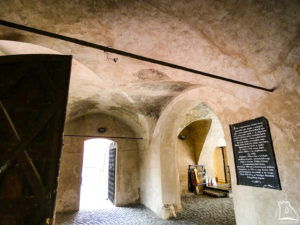Kőszeg

Kőszeg Castle (Güns, Kiseg) is in West Hungary, it is near the Austrian border, famous for its historical character and its heroic siege in 1532. The first mention of Kőszeg Castle is from 802 A.D. in the Chronicle of Einhard it was called “castellum Guntionis”. However, the lower castle was constructed only after the Mongolian invasion of 1241-42.

The origins of the only free royal town of Vas County (Eisenburg) go back to the third quarter of the thirteenth century. It was founded by the Kőszegi family, a branch of the Héder Clan who had settled in Hungary in 1157 A.D. For decades, the town was the seat of the lords of Kőszeg (Güns).

Prince Albert took the castle in 1289. According to the Truce of Hainburg in 1291, Hungarian King András III had the inner castle pulled down. It was only King Károly Róbert who could break the power of the mighty Kőszegi Clan and was able to seize Kőszeg Castle in 1327. It was a year later, in (1328), that he elevated the town to royal status. The town boundaries were fixed during the Anjou dynasty (1347–1381). The king helped the burghers with significant privileges in 1336.

The walls of the town were gradually built out with strong towers to guard the settlement against raids from Austria. The moat was filled up by the water of the Gyöngyös stream. In 1392 the royal town became a fiefdom when the Palatinate Nicolas Garai repaid a bond paid to King Zsigmond of Luxembourg by the Ellerbach family from Monyorókerék. The Garai era ended in 1441. The place went to the Habsburgs in 1445 but King Matthias Corvinus took it back in 1482. however, the Habsburgs could retake it two years after he died in 1492.

The most famous event of Kőszeg castle, Hungary, was its 25-day-long siege in 1532:
After the Defeat of Mohács (1526) the Turks’ next destination became Vienna but Suleiman failed to take it in 1529. At the same time, it became obvious that the split between King Habsburg Ferdinand and King Szapolyai János would remain permanent. Ferdinand launched a campaign against Szapolyai in 1530, targeting Buda Castle. Yet, his general, Roggendorf had to turn back without success.

The Habsburg ruler did not get the appropriate help from his elder brother, King Charles V because he was more interested in the religious wars of the Holy Roman Empire. Thus, Ferdinand tried to make temporary peace with Suleiman and Szapolyai. Suleiman demanded nothing less than the full submission of Hungary as a vassal, and he also included Vienna itself in the list of territories he demanded. As we can see, the Ottoman ruler didn’t give up on gaining the “Red Apple” (Vienna).

Naturally, Ferdinand could not approve his request. Emperor Charles tried to instigate the Persians to attack Suleiman but his diplomatic efforts were in vain, and the war broke out. Let us note a sign of the hopelessness of Ferdinand’s situation that he still sent envoys to Constantinople in the spring of 1532 – but they were met by the marching armies of Suleiman and Grand Vizier Ibrahim Paragli.
So Sultan Suleiman led the Ottoman army in person and it was the third wave of the great wars that the Ottoman Turks led against Hungary in the sixteenth century. Unlike before, this time the Sultan took a different path, he led his army, not along the Danube River but north of the Dráva River, toward Kanizsa castle. Nobody tried to hinder him but due to the bad roads of the West Trans-Danubian Region, his army marched very slowly. It was quite an unlucky plan. However, the smaller castles surrendered before him, except for Kőszeg castle.

Kőszeg became the major flashpoint of the campaign of 1532 as it was guarding the only passable road toward Vienna. The small and old-fashioned Kőszeg castle was defended by a Croatian soldier, the brave Miklós (Nicholas) Jurisics, and his Hungarian, German, and Croatian men. Jurisich often rendered useful services to the German-Roman Emperor Maximilian I (r. 1493-1519) and later to Ferdinand, fighting in the Italian War and becoming Bán (Duke) of Croatia, while he also carried out several diplomatic missions to Constantinople.

They were not numerous and the contemporary world’s strongest army surrounded them, equipped with the formidable Ottoman artillery. There were 130,000 Turks and 80,000 of them besieged the weak castle – 15,000 of them were Janissaries. Kőszeg was the personal property of Jurisics, who had just 46 Hussars and 700 peasant soldiers who took refuge in the castle, defending their 1800 women and 2300 children (or adolescents). The burghers of the town also took up arms but the walls were thin and there was not enough gunpowder. Jurisics knew the enemy well, especially Vizier Ibrahim. During his diplomatic mission, he saved his life on a hunt.





https://www.hungarianottomanwars.com/1490-1541/a-scene-from-the-last-days-of-koszeg-s-siege-in-1532/
The injured captain received the envoys of Suleiman on 29 August and they negotiated the surrender of the castle. Finally, the castle – or its ruins – were only symbolically handed over to the enemy and only their flag was allowed to be put on the tower. At that time, there were barely 200 guards in it. The merits of the defenders were not diminished by the fact that Suleiman was also clearly dragging his feet on the siege, as he wanted to avoid a risky confrontation with the main Christian forces. However, the fortress defenders’ perseverance was far from in vain, as their heroism saved many border forts and settlements from Ottoman conquest and pillage.

After the unsuccessful siege, at the end of August, the Turks moved away towards Vienna with a considerable delay, then returned home, pillaging and sacking Styria on the way back. The heroic resistance of Kőszeg bought time for the Christian armies to arrive and assemble before Vienna. Behold, 120-130,000 Imperial troops were idly watching the heroic fight of Kőszeg. Later, Kőszeg received privileges, and Jurisics got promoted.
Let us pay tribute to the Croatian, Hungarian, and German warriors: their bravery can be compared to the deeds of the soldiers of Nándorfehérvár (Belgrade) in 1456 or the warriors of Drégely and Eger castles in 1552, not to forget the heroes of Szigetvár castle in 1566. Since then, the last stand of Jurisics and his men has remained one of the most glorious battles in Hungarian history, teaching us that we should never give up hope of victory even in the most unpromising of situations.

The history of Kőszeg after the siege
According to tradition, the last contingent of withdrawing Ottoman troops was meant to have left the city limits of Kőszeg around 11 o’clock. As a memorial to this historic heroism, the church clocks in the town have read 11 o’clock since 1777. Prince Bethlen Gábor of Transylvania launched a campaign against the Habsburg ruler in 1619. As the Habsburgs had quite alienating politics against the Hungarians at that time, many of the Hungarian noblemen and towns sided with Bethlen. However, there were a few towns that remained faithful to the Habsburgs in the western part of the Trans-Danubian Region.

When Bethlen quit the siege of Vienna, he sent a letter to the burghers of Sopron, demanding their surrender. As for Sopron, it finally opened its gate before the Transylvanians who used it as a center for their military moves against those towns in the region which did not obey the prince. Soon, Bethlen’s troops set out from Sopron to take hold of Kőszeg, and after a short siege, they took the castle on 14 December 1619. However, the Imperials took it back after a few weeks.

The Transylvanian army returned during the next year’s autumn, and this time they could take Kőszeg only after a long siege. As it turned out, the Habsburg troops occupied it again after a few weeks. These fights and the plunder of the mercenaries caused lots of damage in the town.

After the Ottoman wars, in 1695 the garrison and surrounding areas of Kőszeg fell into the hands of the Eszterházy dukes, where it remained until 1931. The town lost its strategic importance after the War of Independence of Rákóczi (1703–1711). Along with Szombathely, Kőszeg was the most important fortress for the rebel “kuruc” military leadership from 1705 to 1708, to liberate and hold onto the areas west of the Rába River.

Source: partly from Szibler Gábor and Rubicon
Dear Readers, I can only make this content available through small donations or by selling my books or T-shirts:
Please, feel free to support me with a coffee here:
You can check out my books on Amazon or Draft2Digital, they are available in hardcover, paperback, or ebook:
https://www.amazon.com/dp/198020490X or at https://books2read.com/b/boYd81

My work can also be followed and supported on Patreon: Become a Patron!http://Become a Patron!

[wpedon id=”9140″]

https://hungarianottomanwars.myspreadshop.com/all


Here are many nice pictures of Kőszeg and its castle:







































































































